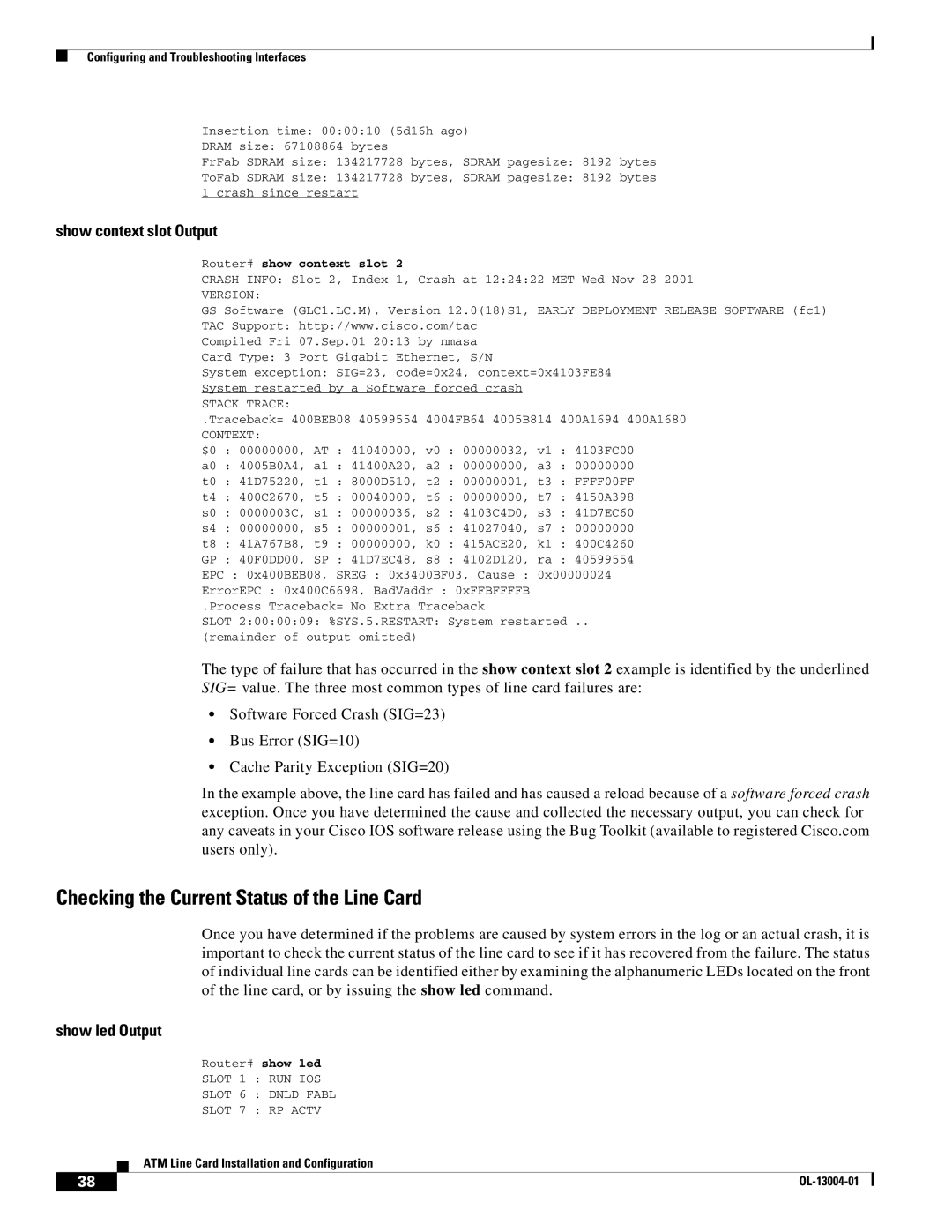
Configuring and Troubleshooting Interfaces
Insertion time: 00:00:10 (5d16h ago)
DRAM size: 67108864 bytes
FrFab SDRAM size: 134217728 bytes, SDRAM pagesize: 8192 bytes
ToFab SDRAM size: 134217728 bytes, SDRAM pagesize: 8192 bytes 1 crash since restart
show context slot Output
Router# show context slot 2
CRASH INFO: Slot 2, Index 1, Crash at 12:24:22 MET Wed Nov 28 2001
VERSION:
GS Software (GLC1.LC.M), Version 12.0(18)S1, EARLY DEPLOYMENT RELEASE SOFTWARE (fc1) TAC Support: http://www.cisco.com/tac
Compiled Fri 07.Sep.01 20:13 by nmasa Card Type: 3 Port Gigabit Ethernet, S/N
System exception: SIG=23, code=0x24, context=0x4103FE84
System restarted by a Software forced crash
STACK TRACE:
.Traceback= 400BEB08 40599554 4004FB64 4005B814 400A1694 400A1680
CONTEXT:
$0 : 00000000, AT : 41040000, v0 : 00000032, v1 : 4103FC00
a0 : 4005B0A4, a1 : 41400A20, a2 : 00000000, a3 : 00000000
t0 : 41D75220, t1 : 8000D510, t2 : 00000001, t3 : FFFF00FF
t4 : 400C2670, t5 : 00040000, t6 : 00000000, t7 : 4150A398
s0 : 0000003C, s1 : 00000036, s2 : 4103C4D0, s3 : 41D7EC60
s4 : 00000000, s5 : 00000001, s6 : 41027040, s7 : 00000000
t8 : 41A767B8, t9 : 00000000, k0 : 415ACE20, k1 : 400C4260
GP : 40F0DD00, SP : 41D7EC48, s8 : 4102D120, ra : 40599554
EPC : 0x400BEB08, SREG : 0x3400BF03, Cause : 0x00000024
ErrorEPC : 0x400C6698, BadVaddr : 0xFFBFFFFB
.Process Traceback= No Extra Traceback
SLOT 2:00:00:09: %SYS.5.RESTART: System restarted .. (remainder of output omitted)
The type of failure that has occurred in the show context slot 2 example is identified by the underlined SIG= value. The three most common types of line card failures are:
•Software Forced Crash (SIG=23)
•Bus Error (SIG=10)
•Cache Parity Exception (SIG=20)
In the example above, the line card has failed and has caused a reload because of a software forced crash exception. Once you have determined the cause and collected the necessary output, you can check for any caveats in your Cisco IOS software release using the Bug Toolkit (available to registered Cisco.com users only).
Checking the Current Status of the Line Card
Once you have determined if the problems are caused by system errors in the log or an actual crash, it is important to check the current status of the line card to see if it has recovered from the failure. The status of individual line cards can be identified either by examining the alphanumeric LEDs located on the front of the line card, or by issuing the show led command.
show led Output
Router# show led
SLOT 1 : RUN IOS
SLOT 6 : DNLD FABL
SLOT 7 : RP ACTV
ATM Line Card Installation and Configuration
38 |
| |
|
